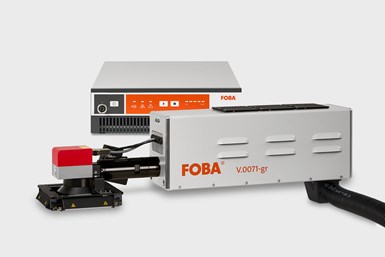FOBA’s Cool-Touch Laser Marking for Delicate Substrates
The low-heat laser is said to apply perfect marks on materials with extraordinary absorption properties, such as white, transparent or red plastics as well as highly reflective metals.
FOBA V.0071-gr 7-W laser marking system is classified laser protection class 4 and must be equipped with a housing or integrated into a marking unit. Photo Credit: FOBA Laser
FOBA Laser has developed a 532-Nm wavelength green laser marking system is designed to offer new possibilities for industrial direct part marking on delicate substrates. Supplemented by FOBA’s marking workflow, it is said the low-heat laser applies perfect marks on materials with extraordinary absorption properties. Those materials include white, transparent or red plastics as well as highly reflective metals. The green laser completes the range of laser wavelengths in FOBA’s portfolio of marking systems.
The green laser is said to offer a significant increase in marking speed and marking quality on previously insufficiently markable materials. Affected materials include special plastics such as UHMWPE, HDPE or PMMA for which additives might no longer be necessary, as well as glass or shiny substrates. Compared to other laser types (such as UV or fiber), the company says the green laser shows better marking results while achieving superior marking speeds.
The application of the green laser marker can be facilitated using FOBA’s laser marking workflow with camera and mark alignment software. “The optical part inspection and validation of marked contents, as well as the automated and precise positioning of the laser mark have long been valued by our customers as a reliable and safe workflow solution”, says Philipp Febel, FOBA director product management. “Our green laser can easily be equipped with various laser alignment tools and works with any of the available FOBA user interfaces.”
The FOBA V.0071-gr and FOBA V.0141-gr green laser marking systems close the gap between UV (355-Nm) and fiber (1,064-Nm) laser markers. The combination of relatively high laser power and a vanadate source enables extended applicability and high speed. “Based on customer requirements, we have developed a leading-edge marking solution with to address the most challenging marking applications,” Febel says.
The marking laser is available with either 7-W or 14-W laser power variations. It can be flexibly integrated into production environments due to a compact design (compared to the UV laser), a broad range of available interfaces and five possible marking field sizes. It is said the lifetime of FOBA’s green laser vanadate laser source is twice the lifetime of a UV laser source, which minimizes the total cost of ownership.
Related Content
-
4 Bright Ideas for Effective Lights-Out Machining
Adopting lights-out machining involves considerations when a machine shop decides to move forward with the process. Here are some tips to a successful implementation.
-
Replace Repetitive Measurement With DIY Robotic Automation
After minimal training, a shop can learn how to use this robotic inspection system configured for a shopfloor application to supersede repetitive, time-consuming, high-mix gaging processes. It can then be redeployed for another application somewhere else in the facility.
-
Reinventing the Wheel with Robot-Automated CNC Multitasking
One race team discovers how to efficiently manufacture a new wheel nut design for the next-generation NASCAR stock car with the help of a CNC mill/turn and a built-in robot.










.png;maxWidth=300;quality=90)






